 Written by Hulet Smith, OT
Written by Hulet Smith, OT
More than just a mobility aid, wheelchairs are truly an extension of the body, helping people to regain independence and move about the world. Helping to compensate for both temporary and permanent conditions, we love that today’s wheelchairs come in a wide range of styles and options to meet the needs of the highly diverse population who use them.
Whether you need a wheelchair for a few days or the rest of your life, retaining freedom and mobility is important, and can make a remarkable difference in your emotional, mental, and physical health.
Our comprehensive guide will assist you through every part of the wheelchair-buying process, answering every question you may have, along with providing the most important aspects to consider to make the best choice to meet specific user requirements.
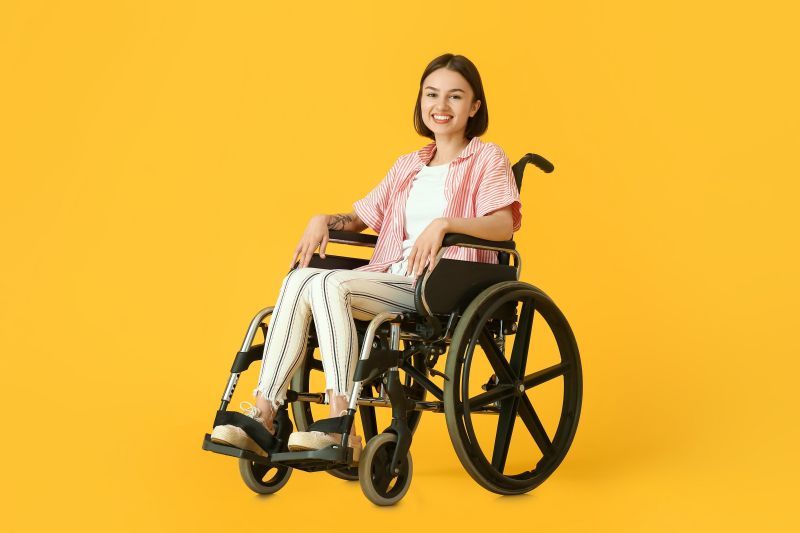
We have included a helpful glossary below of all the different types of wheelchair options.
Aisle Wheelchair: An aisle chair is a common assistive wheelchair used to help people living with mobility limitations more easily board airplanes. Also known as aisle transfer chairs, they are narrower wheelchairs with multiple straps that completely secure the user, with the ability to roll down the smaller aisles of airplanes and other public transportation.
All-Terrain Wheelchair: Available in both manual and power models, an all-terrain wheelchair is specially designed to safely travel over rough terrains, such as dirt, grass, gravel, sand, snow, and even into the water when supervised.
Also known as an outdoor wheelchair, they’re often equipped with oversized balloon-type wheels that enhance maneuverability and stability and use non-corrosive materials to withstand all types of weather. Read our article The 5 Best Wheelchairs for the Outdoors for our best-sellers and important information you must consider before purchasing one of these wheelchairs!
Bariatric Wheelchair: Heavy-duty wheelchairs are usually constructed with reinforced steel, titanium, or aluminum. Bariatric wheelchairs are designed for larger people weighing 350 pounds or more. They feature wider, sturdier seats that may tilt to optimize medical positioning, better accommodating the user’s center of gravity. Top 5 Bariatric Manual Wheelchairs highlights our best products and helpful information when selecting the best bariatric manual wheelchair.
Beach Wheelchair: As a subcategory of All-Terrain wheelchairs, beach wheelchairs are specially designed to hold up to constant contact with water, while they also deliver design aspects that make it easier to roll over sand and rocks, and right into the water. These designs generally require a caregiver or attendant to propel.
Ergonomic Wheelchair: Specifically configured to support the human body along its natural contours, ergonomic wheelchairs are also lightweight and easy to maneuver. Factors such as height, weight, body distribution, and temperature preferences are all taken into account to assist in reducing or preventing pressure points, shear, and discomfort. Proper positioning helps to redistribute the user’s weight, enhancing stabilization. Our article, Strongback Wheelchairs: More Lumbar Support, Less Pain, features the amazing Stronback Wheelchairs and their unique design.
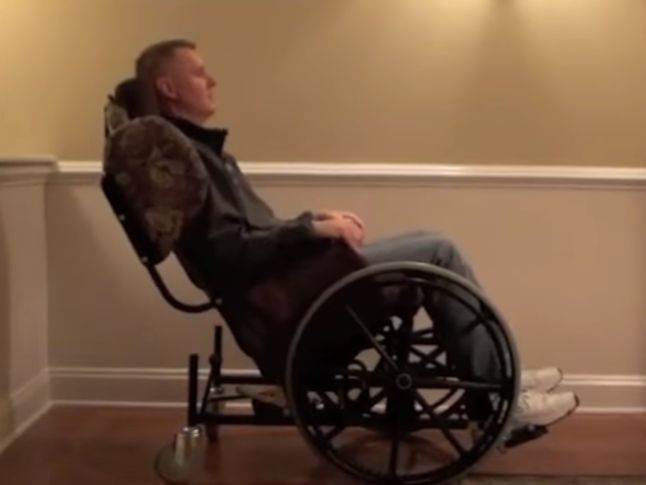
High-Back Reclining Wheelchair: With a back that’s higher than standard wheelchairs, a high-back reclining wheelchair facilitates reclining to a 180-degree position from a 90-degree sitting angle, improving comfort and circulation. This repositioning support is ideal for wheelchair users requiring extra support due to respiratory difficulties, poor trunk or core stability, severe arthritis, quadriplegia, severe multiple sclerosis, or muscular dystrophy. Many people also asked us How does a tilt-in-space-wheelchair differ from a reclining-back wheelchair? and we answered in that article!
Lightweight Wheelchair: Generally weighing less than 50 pounds, lightweight wheelchairs are almost always manual in design and typically made from aluminum, but can also incorporate steel and other metals. They’re easier for riders to maneuver and propel, along with being lighter for caregivers to push. Lightweight wheelchairs also offer simple portability, with many that fold down to fit in a transport vehicle. Check out our best-sellers in our article: The 5 Best Lightweight Manual Wheelchairs.
Manual Wheelchair: As the most common type of wheelchair, manual wheelchairs mobilize by requiring the user to self-propel or be pushed by a companion or caregiver. They feature larger rear wheels for the user to grasp and push, and sometimes have an attendant bar or handles on the back for easier caregiver control. For more in-depth information, our article The 5 Best Manual Wheelchairs has both our best products and a better look into manual wheelchairs.
Pediatric Wheelchair: Offering mobility assistance for children of all ages, pediatric wheelchairs are specially designed to meet the many varied special needs of younger, smaller wheelchair riders. Just like regular wheelchairs for adults, wheelchairs for kids come in a wide range of sizes, styles, and formats, with multiple positioning supports and innovative design aspects to adapt to every child’s unique requirements. Check out our Top 5 Best Pediatric Wheelchairs for a more nuanced look.
Pool Wheelchair: Constructed with non-corrosive materials, pool access wheelchairs are easier to maintain around water, direct sunlight, and humidity than standard wheelchairs. Often used to provide access for people in public pool and spa facilities, pool wheelchairs are designed to dry quickly, and have specially designed wheels that won’t scuff or mark the flooring.
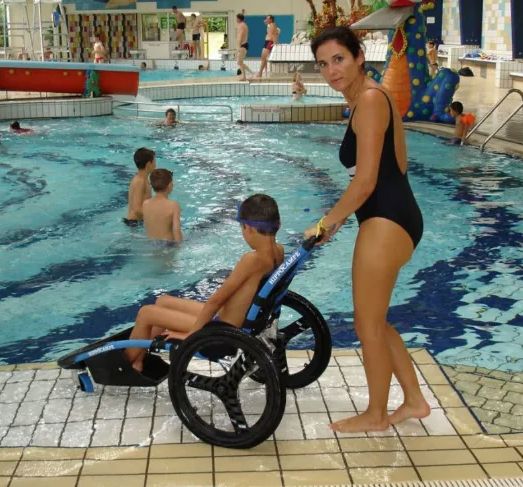
Power Wheelchair: Perfect for people unable to propel manual wheelchairs, power wheelchairs utilize battery systems and electric motors to mobilize. Also known as an electric wheelchair, an EPW (Electric-Powered Wheelchair), or a motorized wheelchair. A power wheelchair helps riders move about both indoors and outdoors with simple control, making these chairs a good choice for anyone with more physical involvement. We feature our 5 Best Electric Power Wheelchairs and Top 5 Portable Power Wheelchairs for Travel in two informative articles.
Sports Wheelchair: With a wide array of frame configurations specially formatted to meet the various demands of different sports, sports wheelchairs provide specific safety aspects along with reinforced and heavy-duty construction to withstand athletic and competitive sports applications. Even though they’re robustly designed, they’re often exceptionally lightweight for easier maneuverability.
Stand-Up Wheelchair: A stand-up wheelchair is a medical device that enables wheelchair users to stand safely with the help of innovative technology design aspects. Recommended for anyone with mild to severe disabilities, standing wheelchairs facilitate much easier transitions from sitting to standing positions, sometimes without requiring any caregiver assistance. Standing frames help wheelchair users attain and retain better health, aiding in the prevention of medical issues often associated with prolonged and extended sitting positions.
Tilt-in-Space Wheelchair: Providing exceptional pressure relief, tilt-in-space wheelchairs help to redistribute the wheelchair user’s weight and provide unique positioning to improve health and comfort. Because a large portion of body weight is placed on the buttocks, back, and back of the thighs when sitting upright, which can create discomfort for extended periods, the tilt-in-space design helps reposition the user at various angles to optimize comfort and support healthy body processes.
Transport Wheelchair: Utilized for a wide range of mobility purposes, transport wheelchairs are designed for a caregiver or attendant to push. They’re made with smaller wheels that the occupant would not be able to self-propel and are often used to transport patients within medical, rehab, or care facilities. Transport chairs are usually much lighter in weight, with formats that are easier to propel for a caregiver or companion. Learn more about transport wheelchairs by reading our article on the 5 Best Lightweight Transport Wheelchairs.
Ultra-Lightweight Wheelchair: Lightweight manual wheelchairs are easier for people to maneuver, self-propel, and travel with, along with being simpler for caregivers or companions to mobilize and store. Generally weighing less than 25 pounds, ultra-lightweight wheelchairs are a great choice for more active riders as they’re so much simpler to turn and control.
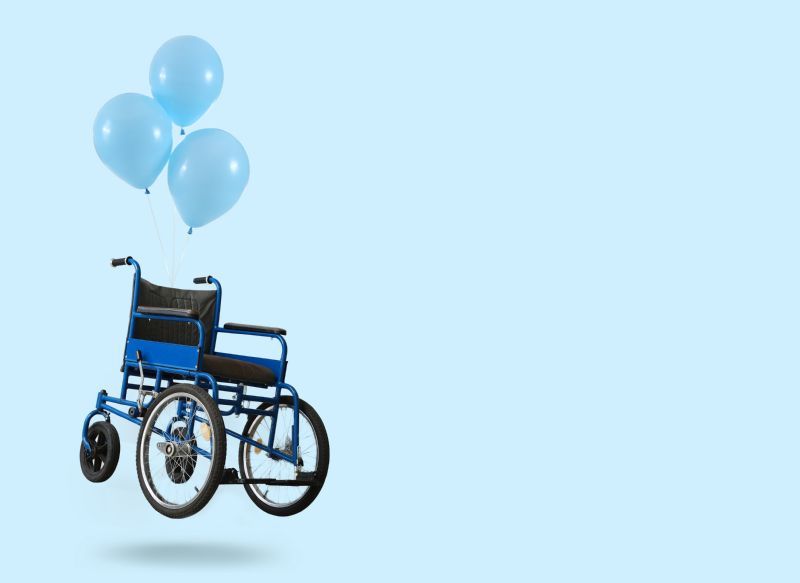
Seat width: The seat width should be wide enough to accommodate the hips without pinching or being too snug, but not so wide that you have to stretch to reach the wheels when you’re self-propelling. In our experience, when a wheelchair is too wide, the user tends to fall or slouch to either side in an unhealthy posture, and it may also be much harder to turn or get through doorways and other smaller spaces.
Seat depth: Generally, to avoid blood vessel constriction in the legs, the seat depth should be two inches away from the back of the knee.
Seat height: If the wheelchair user needs to use their feet to propel or turn, the height of the seat should enable them to reach the floor with their heels. Wheelchairs with footrests often have a higher seat height and will not permit this, but can be better suited for pulling up to a dining table to eat or play games with others.
Back height: For users who need support, we recommend a full-length backrest, along with a headrest. Other wheelchair users may prefer a shorter back that enables more movement within the chair.
Armrest height: The user’s arms should be comfortably supported in a natural, resting position. Other positioning devices and adjustable armrests can provide the right fit for various needs.
Footrest length and style: The wheelchair user’s legs should never be allowed to dangle, nor should they be pushed too high, which leads to pelvic tilt. Leg rests and footrests can be adjusted for different kinds of shoes, along with adjusting for comfort for swollen or painful legs. Additional accessories, such as calf supports can also be employed for stay-in-place reclining.

It’s important to remember not all individuals who use a wheelchair do so for the majority of their waking hours. Sometimes, a wheelchair is a supplementary transport or is used in place of another device from time to time.
For those who do call a wheelchair their primary mode of transportation, considerations will be different than for those who only use a wheelchair some of the time. People who spend the majority of their time in a wheelchair require a chair with features that go beyond standard inclusions.
Are you going to be using your wheelchair full-time, or as a mobility solution only for certain situations? Additionally, will you be using the wheelchair for a relatively short time or is it a permanent addition to your life? We recommend considering these two questions to help you make a better determination on which type of wheelchair might be best for your needs.
For short-term applications, a simpler manual wheelchair might be a good solution, while those looking for a permanent wheelchair should consider a design with more support options, skin protection, and a customized fit.
If you only need your chair for a short time and you have someone you can depend on to push your chair for you, then something like a standard manual wheelchair or transport chair might be a good cost-effective solution for easy mobility.
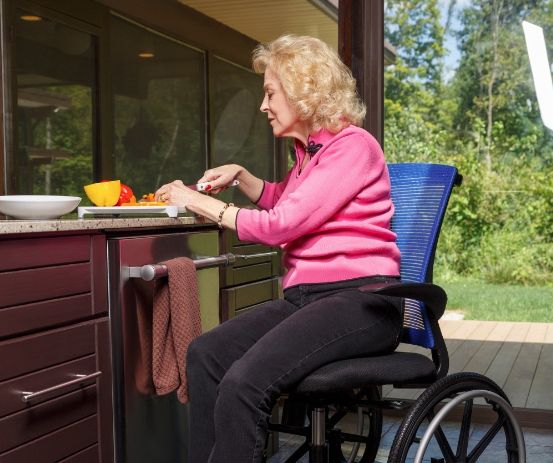
Generally, smaller and more narrow than standard wheelchairs, transport wheelchairs have smaller wheels and are easier to navigate and control for caregivers and attendants. In our experience, because they can’t be manually controlled by the rider transport chairs are well suited for short-term use, such as post-op, or during injury recovery, along with secondary use in combination with a larger electric or manual wheelchair.
Regular manual wheelchairs offer a good mobility option for both the short and long term, especially for users who retain upper body strength and can self-propel. In our experience, electric or power wheelchairs are better suited for riders with injury, disability, or illness challenges that prevent them from self-propulsion.
Power wheelchairs are also recommended for long-term use, as they are often roomier and have more positioning supports than their manual counterparts. For people with degenerative conditions or the elderly, we recommend electric wheelchairs as they are preferable because they require very little control or strength on the part of the user. They also tend to be larger and heavier than manual wheelchairs, but many of today’s power designs can fold down into separate components for easier transport by vehicle. If you are interested in purchasing a power wheelchair check out our article on The 5 Best Electric Power Wheelchairs.
Ergonomic and customized wheelchairs include a host of various design elements to make extended sitting as comfortable as possible, with tilt-in-space and reclining functions to improve energy and reduce fatigue, adjustable height and or width seats, armrests, and footrests to provide the perfect fit, and flip-away and/or removable armrests and footrests to improve access for frequent transfers.
If you’ll be using an electric wheelchair for extended amounts of time, we recommend finding one with plenty of battery power, along with a backup battery or two to ensure you always have power when you need it.
Some wheelchair designs, especially those for children, include a wide variety of accessories or design features that enable modifications and adjustments as the user’s needs change, making them a much more cost-effective selection for the long term.

If your motor control is compromised or you have difficulty supporting your upper body as well as your lower body, then we recommend you consider a high-back wheelchair, or a chair with increased safety and support options like safety belts, headrests, and lateral stabilizers.
If you need somewhat less support but are still going to be using your wheelchair mostly full-time, then a lightweight ergonomic wheelchair is a great middle-ground between a standard manual wheelchair and the ultra-supportive high-back chair.
Similar to ergonomic designs for wheelchairs, reclining wheelchairs are constructed for patients who will spend extended amounts of time in their wheelchairs and desire a degree of flexibility. As the name implies, reclining wheelchairs are capable of adjusting backward, with many of these designs extending close to an entirely flat resting surface.
For patients who spend the majority of their time in their wheelchairs or those who depend on their wheelchairs to provide a high degree of upper body stability, a reclining feature allows them to adjust positioning without requiring they leave the chair to do so.
For people who tend to get fatigued from sitting upright all the time, tilt-in-space wheelchairs enable users to recline at various angles, mitigating this exhaustion and improving overall sitting endurance and tolerance.
Standing wheelchairs also improve the health of their users with the employment of specific design aspects that enable users to stand up, benefiting the respiratory and digestive systems and other physiological processes.
If falling over is a concern, or if the intended user doesn’t have a lot of core strength and/or motor control is compromised, we recommend a wheelchair with a deeper bucket. High-back reclining designs, a stand-up, or a sit-to-stand with increased safety options may be the best fit.
If the intended user has good core strength and can sit up an upright manual wheelchair may be the best option, especially as the user can stay fit through self-propulsion. A lightweight manual wheelchair would be a good fit for someone who often relies on a caregiver or attendant for propulsion, and is lighter and easier for self-propulsion as well.

Some people can self-propel, while others can do it only intermittently. Some wheelchair users may require someone to push their wheelchairs 100 percent of the time. If you can push your wheelchair independently and you want to do this, then we think a manual wheelchair would be a great fit for you. If you can’t mobilize your wheelchair on your own, or you simply don’t want to, then a power chair or scooter is probably the best solution for you.
Different patients have varying physical needs, for this reason, it’s important to consider which type of wheelchair operation best suits you or the one you love. For users who possess a good amount of upper body strength, or are only limited in mobility from the waist down, a manual wheelchair can be a great choice. We love that manual wheelchairs can help the user retain upper body muscle strength and allow them to play an active role in their mobility.
A powered wheelchair is better suited for an individual who cannot wheel themselves, or who spends a significant amount of time in a wheelchair and cannot sustain their transport on physical strength alone. Good examples of this would be limited-mobility students navigating a college campus in their wheelchair, or users who still desire to go on leisurely walks around the neighborhood.
Manual wheelchairs can be operated one of two ways: with the help of a caregiver pushing from behind or the patient propelling the wheelchair by gripping the wheel area and pushing in the direction they wish to go. Lightweight manual wheelchairs are easier to maneuver for both the rider and the attendant. We recommend an ultra-lightweight wheelchair for people new to using wheelchairs or those recovering from surgery or injury, as they help users build their strength more slowly, without overstraining. If you feel like you need a lightweight wheelchair and want more information on the topic, please read our article on The 5 Best Lightweight Wheelchairs.
Most standard manual wheelchairs feature the essentials: a backrest, seat, footrests, and wheels. These chairs are more portable than their powered counterparts and are typically less expensive. They also can be used by a multitude of patients, which makes them particularly valuable tools in a hospital environment.
Manual wheelchairs may also be specialized to address the needs of patients who will use them long-term. These specializations most commonly include reclining abilities and ergonomic designs. Power wheelchairs, on the other hand, use a full electrical system directed by a control stick that’s operated by the rider.

Taking into account the size and weight of the primary wheelchair user is incredibly important, because not only do you want to ensure that the wheelchair you choose will support your weight, but your wheelchair must be properly sized and adjusted to prove proper posture support.
Taking accurate measurements of your body is an integral part of choosing the right wheelchair for your needs, helping to ensure that the chair you ultimately choose is perfectly fitted to your body, supporting your posture and maintaining comfort. This meticulous measurement is somewhat less important for short-term chair needs, but weight capacity and height are still just as crucial in our experience.
Bariatric wheelchairs are specially designed to safely and comfortably accommodate users who are larger or heavier than average. Their heavy-duty construction often features enhanced bracing supports for safety and stability along with a wider seat for a comfortable fit.
It’s important to remember that bariatric designs often weigh more than standard wheelchair models, especially if accessories are added. If you don’t have a lot of upper body or core strength, we think it may be too challenging to use a manual bariatric wheelchair and a power model should be chosen instead.
Pediatric wheelchairs are specially constructed for children to use and are often available in configurations that will grow along with the child, precluding the need for additional wheelchair purchases every year. Finding the best pediatric wheelchair selection for your child depends on their level of physical and cognitive involvement, and what kinds of supports and adaptations they require for healthy positioning and safety.
We love that some wheelchairs are completely customizable for both children and adults, with a specific seat width and depth, leg-rest, footrest, and armrest options, wheel and brake choices, and a wide array of other selections to ensure the perfect fit and accessories. Others are adjustable, with height and width ranges that can easily be changed, even when occupied.

While today’s wheelchairs are lighter more comfortable and maneuverable than ever before, it’s estimated that 80 to 90 percent of wheelchair users are using a chair that doesn’t fit their body. Choosing the right wheelchair can maximize your mobility and posture and prevent chronic discomfort or other medical problems. In our experience as occupational therapists, the proper fit will improve swallowing, breathing, and digestion while preventing pressure wounds, pelvic and hip problems, and general discomfort and fatigue.
The ideal wheelchair sitting position follows the 90-90-90 rule, which creates a 90-degree bend in the hips, a 90-degree bend in the knees, and a 90-degree bend in the ankles. The user should sit back in the seat, with their buttocks making contact with the wheelchair back. Knees should be in line with the hips, and not above or below, and the thighs should be parallel to the ground.
Skin shear refers to the force of gravity that pushes down on the body with resistance between the user and their wheelchair, while pressure sores or wounds (also known as decubitus ulcers) form from repetitive, irritating pressure to the same place on the body, usually the more bony prominences. We know that both conditions are painful, hard to treat, and can lead to more severe problems. It’s best to prevent them whenever possible.
Like anyone who sits excessively, wheelchair users are often more susceptible to developing pressure wounds and skin shearing. One of the best ways to prevent this in our opinion is by selecting an ergonomic or tilt-in-space wheelchair that’s specifically designed to offload pressure, friction, and shear. Tilt-in-space wheelchairs help to shift the weight from the buttocks to the back, reducing pressure.
Ergonomically designed wheelchairs are specially constructed to provide comfort to patients more prone to developing these pressure and shear problems. Ergonomic wheelchairs typically include a unique, cushioned seat to prevent patients from getting sores, which can appear after extended time spent in the wheelchair. If you or your loved one will be spending long amounts of time in the chair, we recommend considering an ergonomic wheelchair design.
Stand-up wheelchairs also offer tremendous help in the prevention and treatment of pressure ulcers and skin shear, as they help users retain standing positions and break up sitting throughout the day.
Incorporating the right positioning devices is another great way to reduce the risk of pressure ulcer development. While most wheelchairs offer patients a soft, comfortable seat during transportation, many models provide their users with additional comfort through the use of padded cushions and seat cushions which help to distribute weight more evenly.
This padding also serves as an added safety measure, helping to prevent any injury from a collision in the wheelchair. Depending on the patient’s needs and the amount of time they’ll be using the wheelchair, padding can provide a supplemental degree of comfort, and can prevent heat and moisture buildup as well.
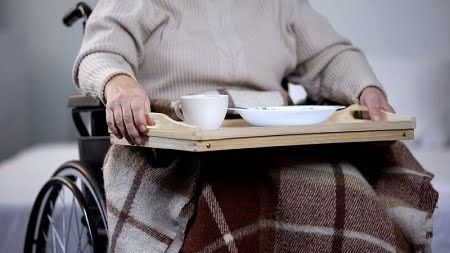
Different wheelchair users will require different added features and accessories to improve comfort, prevent injury, and increase mobility. Anti-tip devices are a low-cost addition that can prevent potentially fatal skull fractures, while a locking brake handle extension provides stay-in-place reliability.
We recommend considering adjustable armrests to improve comfort and posture, or removable armrests because they are convenient when sliding up to a table or desk. Elevating leg rests promotes healthy blood flow and can reduce edema and swelling, while a headrest optimizes comfort for all-day sitting.
If you’ve found a wheelchair you like, you’re trying to decide between a few models, or you’re having difficulty finding a single wheelchair with all of the features you want, remember that there is a wide range of wheelchair accessories on the market to help you modify a wheelchair for your specific needs. In our experience, the most common types of accessories are wheelchair cushions, trays, and bags, but there are innumerable accessories made to help you customize your wheelchair to your exact specifications, even a spot for your fishing pole!
For many wheelchair users and caregivers, wheelchair portability, and necessary storage space make a big difference in the wheelchair model they select. With this in mind, many of today’s models are designed to be easy to fold and store.
Whether through folding or disassembly, a wheelchair’s ability to become compact can be one of its best-selling points. Therefore, people who are likely to take their wheelchairs with them for travel, or those who need to store the wheelchairs when it’s not in use should consider a wheelchair’s portability before making a purchase.
Innovations to the power wheelchair have made multiple electric models just as portable as their manual counterparts. With their ability to be disassembled into smaller parts that are lighter in weight, electric wheelchairs can now often be carried inside a vehicle. There are also easy-to-use vehicle-wheelchair lifts that can transport your wheelchair on the outside of the vehicle. If you need a power wheelchair you can travel with, check out our top portable power wheelchairs to help you find the best one for your own needs here.
A wide selection of manual wheelchairs offers folding or collapsibility, making them easy to travel with, as well. They can often be folded down to fit on public transportation, especially the lightweight models. More wheelchairs are being designed this way, including all-terrain and tilt-in-space, as manufacturers gather input from their end-users and find exciting new technology to meet their customers’ demands.
Lastly, adapting your environment to become wheelchair accessible is critical in remaining mobile with your chair. You may need to install a wheelchair ramp at the entryway of your home. For more information on wheelchair ramps check out our article The Ultimate Wheelchair Ramp Buying Guide.
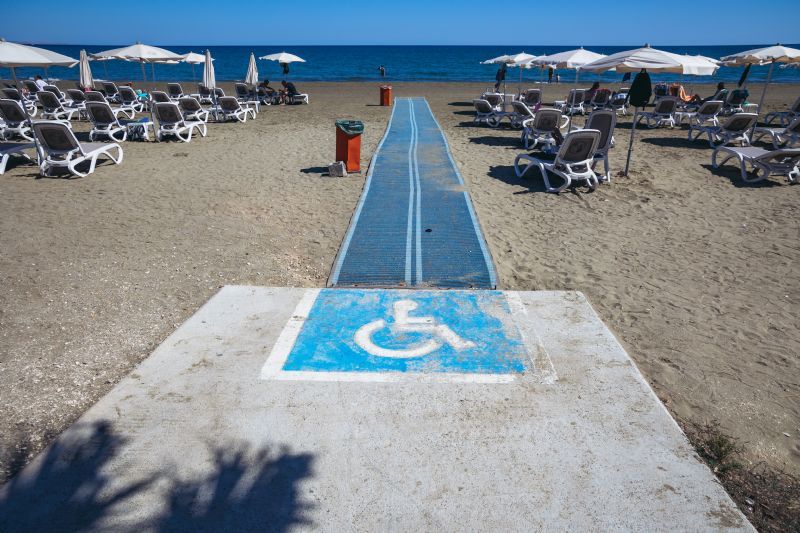
How you intend to use your wheelchair will help you determine the best selection to meet those needs. Some wheelchair users may have more than one wheelchair, with one that’s used for outdoor activities, and another that’s used more for indoor applications. In our experience, size is important, and measurements should be considered for every possible scenario, such as how the seat height will line up with the bed for transfers if it can get through every doorway, and if the turning radius is tight enough for smaller indoor spaces.
If you love outdoor activities, access a pool, or go to the beach, you may also want an all-terrain wheelchair in addition to your regular chair. People who live mainly indoors or those who usually travel on paved roads and sidewalks tend to do well with a standard manual wheelchair. Beach wheelchairs are ideal for anyone living near a beach or sandy area, while pool wheelchairs are specially made for aquatic therapy and physical rehab/recovery, along with safer pool recreation.
If you are looking for more information about outdoor wheelchairs, our article The 5 Best Wheelchairs for the Outdoors would be a great place to start.
If you need additional assistance approaching your need for a new wheelchair, we are happy to help! Please contact our team for further assistance with your selection, or search our resource guides on Caregiver University for more information.

Co-founder/CEO of Rehabmart, Pediatric Occupational Therapist, husband, and father. Passionate about connecting special needs kids with superb nutrition, sensory integration, and complementary health strategies. Excited about Rehabmart's mission to become the premier online educational platform which empowers caregivers by spotlighting innovative devices and interventions to achieve optimal patient response and recovery.